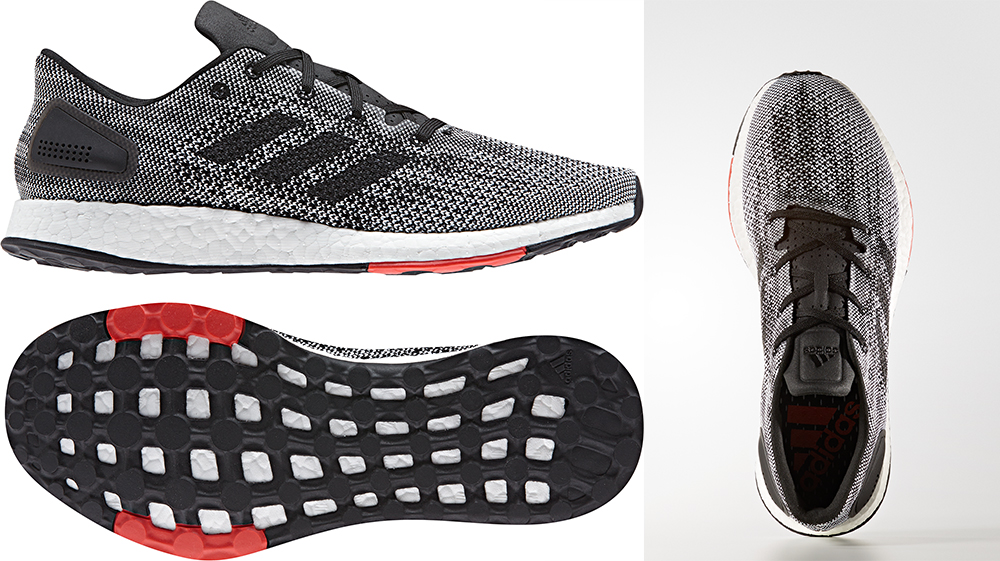You can trust Coach
You might think that city running is not a new concept – and you’d be right. People have run in cities since there were cities. However, there is a new type of city runner that has evolved in recent years.
These runners swerve traditional running clubs in favour of the many free groups that now operate in city centres – weekly social runs that visit the more scenic parts of the city. Again, maybe not a new idea, but it’s now more Instagrammable than ever, thanks to the existence of Instagram.
Adidas has made a bid to claim these runners not only with its own group, Adidas Runners, but also with dedicated shoes – first the PureBoost and now the PureBoost DPR, both of which have several features designed to excel when weaving along busy pavements and turning sharp corners. They also look cool and could adorn the feet of pub-goers and commuters just as easily.
However, the PureBoost DPR should not be casually dismissed as a fashionable shoe that’s only worth wearing on short, photogenic runs. It’s an excellent performance shoe that immediately became my race-day favourite.
Compared to the Pure Boost (298g for UK size 8.5) and the wildly popular UltraBoost (304g), the PureBoost DPR is a featherweight, clocking in at 244g. That’s the same heft as Adidas’s AdiZero Boston 6 and not far off the AdiZero Adios 3 (226g), which are both excellent racing options for middle- and long-distance runs.
However, the PureBoost DPR should not be casually dismissed as a fashionable shoe that’s only worth wearing on short, photogenic runs. It’s an excellent performance shoe that immediately became my race-day favourite.
Compared to the Pure Boost (298g for UK size 8.5) and the wildly popular Adidas UltraBoost (304g), the PureBoost DPR is a featherweight, clocking in at 244g. That’s the same heft as Adidas’s AdiZero Boston 6 and not far off the AdiZero Adios 3 (226g), which are both excellent racing options for middle- and long-distance runs.

Like the best running shoes, the DPR’s lightweight body doesn’t sacrifice cushioning either, with plenty of Boost foam packed in to ensure you bounce merrily through your runs. The design and weight make it an excellent in-between option for runners who want something lighter than the UltraBoost but require more support than that provided by racing flats.
Marking the DPR down as a shoe to be confined to short city runs, then, sells it short. I found it was a great pick for road runs up to 15 miles (and probably longer, if I’d bothered to go any further) and I especially enjoyed wearing it during faster 5K and 10K runs and a 10-mile race. The support-to-weight ratio is spot on.
There are some specific features Adidas has built into the DPR that make it especially suited to city running. Like the PureBoost, the DPR has a wide forefoot to make you more stable as you dash around corners and dodge slow-moving pedestrians. Your foot sits deeper in the DPR (hence the name) so it feels more responsive when running than the PureBoost, although I’d suggest that feeling is magnified by the fact it’s lighter too.
Where the DPR really shines compared with both the UltraBoost and the PureBoost is its upper. It’s still a knitted number, but it’s far lighter and more breathable. Extra support means your foot doesn’t slide around too much when you round corners, a problem that can occur with knitted uppers in general. It’s worth mentioning that the DPR also has a normal tongue, if that’s the kind of thing that bothers you.
The design is excellent on the DPR – like most of Adidas’s shoes it can be worn pretty much anywhere. To my eye the limited edition black/rainbow speckled colourway (£129.95) is by far the coolest, but I accept that’s a matter of opinion. It’s just that any opinions to the contrary are wrong.
If you’re struggling to decide which Boost shoe to go for, I’d suggest that unless you have a very heavy landing when you run and so really want a lot of support, the DPR is your best bet. It’s bouncy, relatively lightweight and gorgeous to look at (especially in the rainbow colourway).

Nick Harris-Fry is a journalist who has been covering health and fitness since 2015. Nick is an avid runner, covering 70-110km a week, which gives him ample opportunity to test a wide range of running shoes and running gear. He is also the chief tester for fitness trackers and running watches, treadmills and exercise bikes, and workout headphones.

